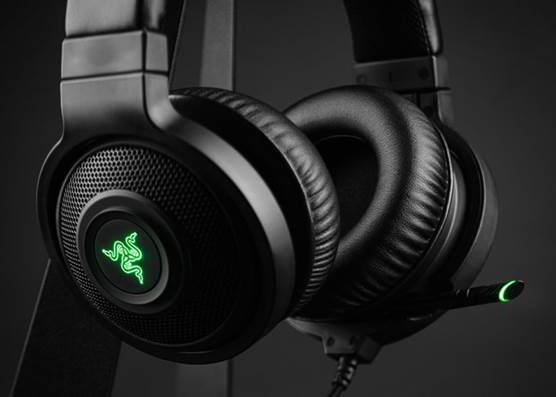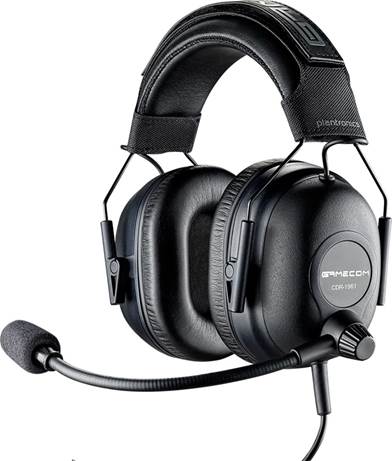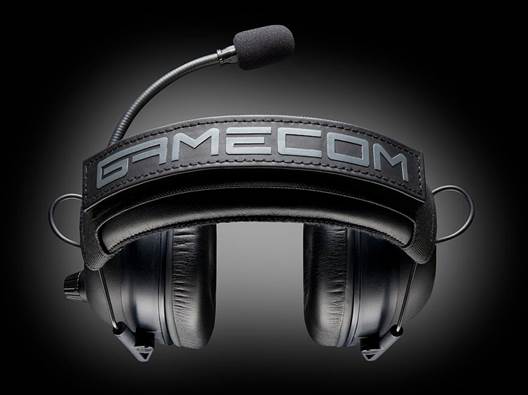There are no buttons, dials or gizmos on the Kraken itself.
The body of the headset only features a retractable microphone. In our opinion
this is a much more elegant design when compared to the raised boom microphone
stow-away option found on other contenders, such as the Sennheiser PC 363D. The
Kraken can only be plugged in to a computer via USB.
A large part of the Kraken's functionality is derived from
Razer's Synapse 2.0 software service. This unified configuration software
allows the user access to a great degree of customization. For example, the
Kraken's virtual 7.1 surround sound channels can be tweaked individually with
respect to position. Gamers can also access EQ settings, activate bass boost
and balance incoming voice audio.

Razer Kraken 7.1
Overall, the Kraken most definitely meets the mark set by
the Sennheiser PC 363D with regards to gaming performance. The fact that users
can calibrate and adjust the 7.1 virtual surround sound effect according to
their own preferences means that their gaming performance definitely
experiences a boost. In our opinion the Kraken is an excellent headset for FPS
fanatics. However, it must be noted that the Kraken does falter when it comes
to music performance. Sluggish mids and boomy bass means that certain songs and
tracks are not rendered as well as they should have been.
Plantronics GameCom Commander
Plantronics, a bit like Sennheiser, are known for their
proficiency with audio products not related to gaming. But they do have a 7.1
gaming headset available to gamers in the form of the GameCom Commander.
Looking at the GameCom Commander gaming headset, the design
is clearly inspired by the aviation and industrial aesthetic. The visible thin
wire body structure and hard plastic shelled ear-cups look like a direct homage
to cans pilots would wear. The top of the headband features a removable velcro
tag. On the whole, there is no middle ground with the looks of this Plantronics
gaming headset. You are either going to love or hate the look.

Plantronics GameCom Commander
The first thing you realize, when you put the GameCom
Commander on, is the weight. The headset is quite heavy and the heft is very
perceptible. The oval shaped cushioning is adequately large but not roomy due
to shallow depth of the pads. A large degree of swivel and the fact that the
structure wires are quite flexible keeps the headset's contact pressure low.
But the primary problem with the Plantronics headset is over-heating. Coupled
with the aforementioned heavy weight, the GameCom Commander cannot be
comfortably used for long durations.
On the left ear-cup you'll find a boom microphone which can
be swiveled through approximately 270 degrees. The microphone can be bent into
position, but the stiffness of the arm makes minute re-adjustments hard to
make. Travelling down the wire from the ear-cups reveals a clasp that
Plantronics has christened quick disconnect. Gamers can just unlatch the two
halves and swap wires which are designed for use with the PC or smart devices.
Just a bit further down on the wire is a control pod for adjusting volume, and
muting the microphone.

GameCom Headphones
Like the Sennheiser PC 363D, the GameCom Commander can be
plugged in to your PC via 3.5mm connector, or USB. Continuing with the
similarities, this Plantronics headset is also equipped with Dolby Headphone
and Dolby Pro Logic Ilx functionality, along with a USB sound card. A slider on
the right hand side of the USB card is used to turn it on, with an accompanying
blue indicator light.
With regards to music, the tone of the GameCom Commander is
slightly tinny and thin. On tracks like Adele's Melt My Heart To Stone the mids
lacked the characteristic warmth and soul the listener expects. Gaming
performance for the Plantronics is also slightly disappointing. While the 7.1
virtual surround soundstage is good it does not match the accuracy of audio
direction delivered by the Razer and Sennehiser products. We also found in-game
alerts for RTS titles, like StarCraft II: Heart of the Swarm, to be slightly
muffled as well.